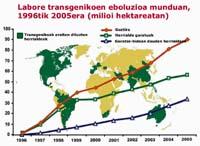Ten years of uninterrupted growth

ISAAA, responsible for the applications of biotechnology in agriculture, has published another year the report on GM productions. According to the data presented, there is no doubt that GM agriculture is constantly growing.
Ten years have passed since the first GM crops began to be commercialized. Since then, genetic agriculture has only grown. In fact, GM crops now occupy 50 times as much surface as in their beginnings. In 1996 they were only cultivated in six countries and occupied 1.7 million hectares. Last year there have been GMOs in 21 countries totaling 90 million hectares.
Outstanding soy
Soy is the most cultivated GM, with 60% soy in GM crops. In addition, more than half of the soya that is sown is transgenic. After soya is cotton, followed by a rapeseed called Canola and corn.

Both soy and other varieties are transformed to be tolerant of herbicides. Thus, herbicides kill weeds in the field without harming the planted. Other transgenic varieties, on the other hand, have been transformed to be resistant to insects, thus avoiding insect pests. And some varieties collect both characteristics. In all cases, the goal is to improve performance, that is, concentrate it a lot.
Other times biotechnology is used to give other characteristics to the plant. For example, golden rice was created to prevent vitamin A scarcity. This transgenic rice has much more vitamin A than the traditional one.
In the European Union
However, many consumers still look with suspicion at GMOs, especially in Europe. Moreover, until recently in European countries transgenic varieties have not been authorized. But gradually the European position becomes more flexible. There are authorized varieties and GM maize is growing in surface.

Within Europe, Spain has been the country that has planted the most transgenic maize since the beginning, and remains a leader today. Transgenic maize is also produced in Portugal, Germany, France and the Czech Republic, and year after year its surface increases.
Mega-producers
ISAAA calls the countries where GMOs occupy more than 500,000 hectares. They are fourteen in total, being the only one in the European Union: Spain. By far, the United States is the country that produces the most. It is followed by Argentina, Brazil, Canada and China, and the rest are Paraguay, India, South Africa, Uruguay, Australia, Mexico, Romania and the Philippines.





